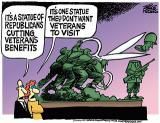August 7 2014 On Mother’s Day 2010, Marine Sgt. Thomas Bagosy told his wife that he loved her and that he had completed his two purposes in life: He had served his country and helped bring their children into the world.
The next day, after a battle with post-traumatic stress that spanned nearly half a decade, he put a .22 caliber pistol to his head and shot himself.
His wife, Katie Bagosy, found out several hours later when a casualty notification officer from Camp Lejeune, N.C., pulled up to her door. In his hand: a gigantic three-ring binder with a fading American flag plastered from cover to binding and the “Widow’s Survival Handbook” nestled within.
“He hands me this gigantic binder with ‘the days ahead’ written on the side,” Bagosy recalled. “It was too much to deal with.”
After more than 13 years of war that have killed 6,808 service members, thousands of spouses of the fallen have found themselves in the same position — forced to navigate a complex and often perplexing system of benefits. And although the nation has largely moved on from Iraq and Afghanistan, the federal benefits system has made it hard for some survivors to do the same. read more>>>























No comments:
Post a Comment